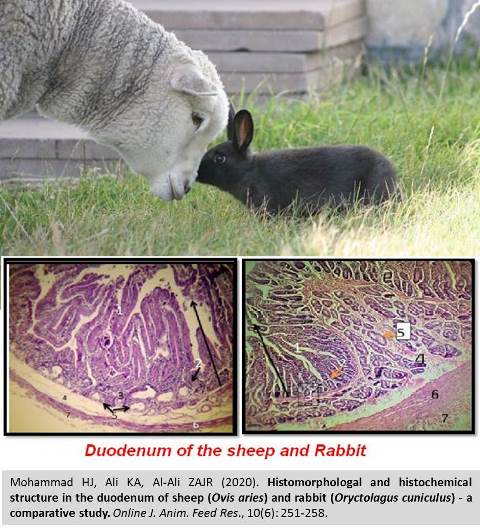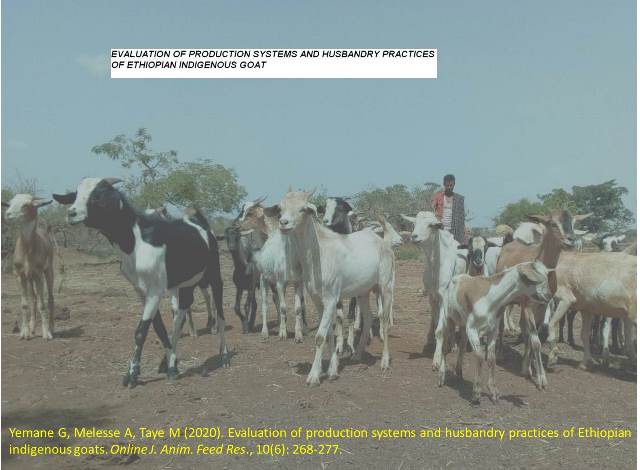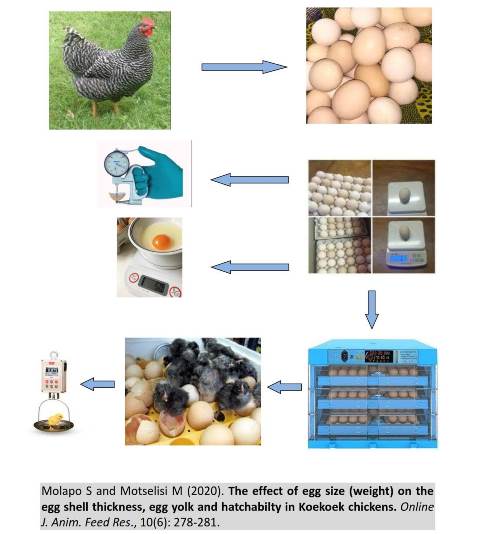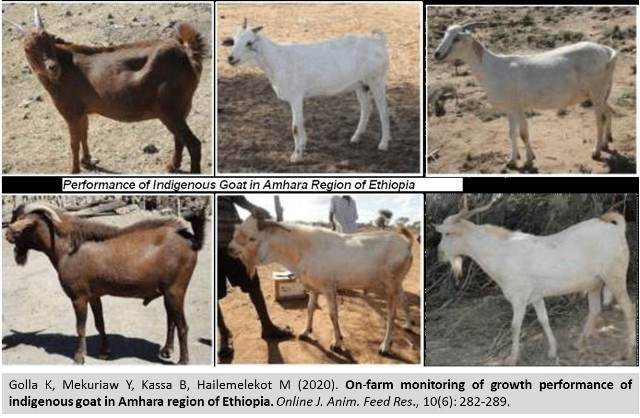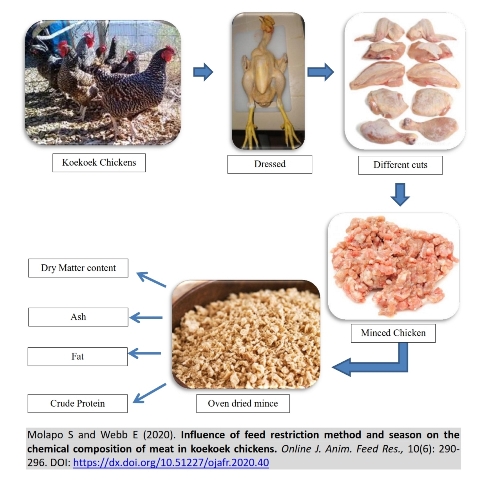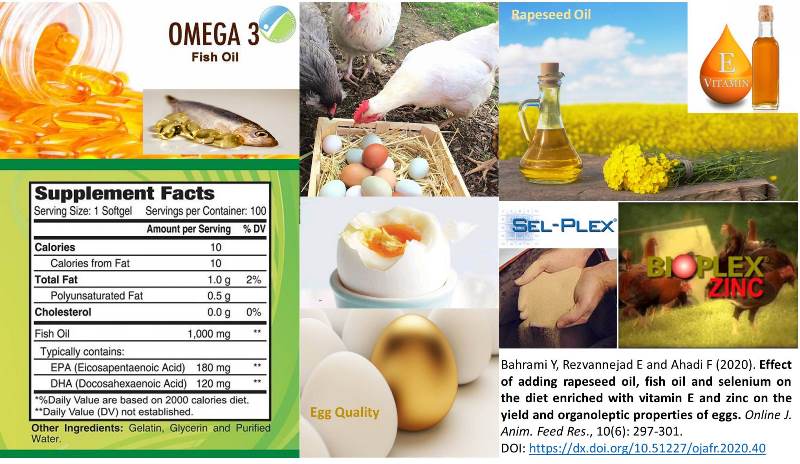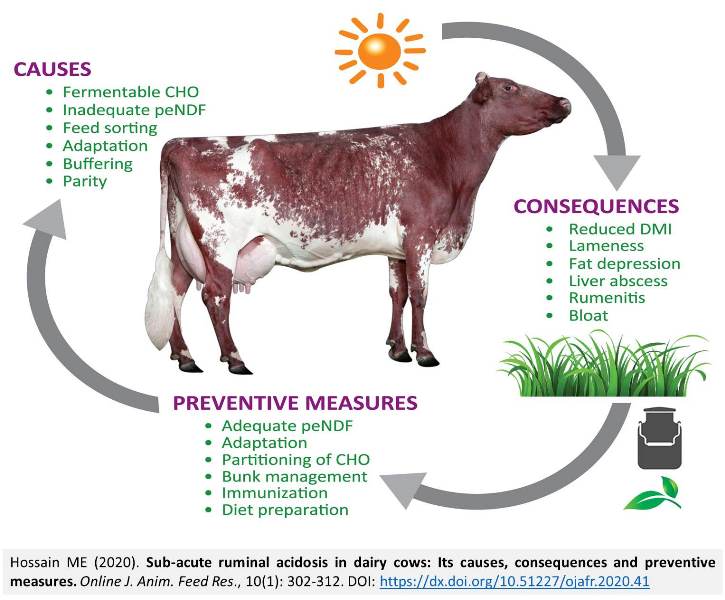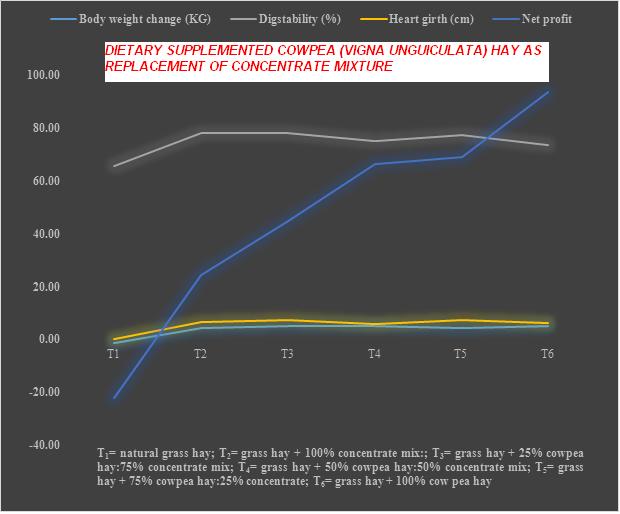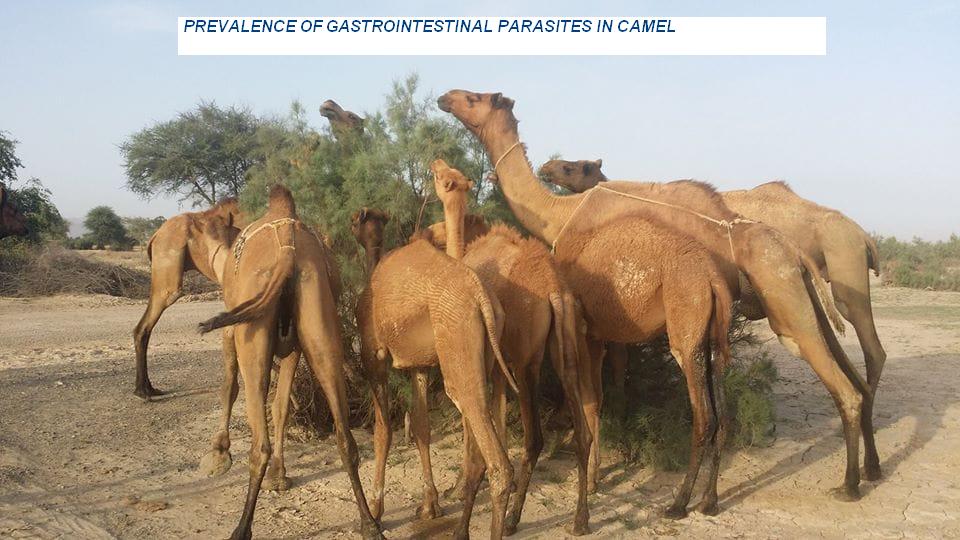Previous issue | Next issue | Archive
![]() Volume 10 (6); November 27, 2020 [Booklet] [EndNote XML for Agris]
Volume 10 (6); November 27, 2020 [Booklet] [EndNote XML for Agris]
Histomorphologal and histochemical structure in the duodenum of sheep (Ovis aries) and rabbit (Oryctolagus cuniculus) - a comparative study
Mohammad HJ, Ali KA, Al-Ali ZAJR.
Online J. Anim. Feed Res., 10(6): 251-258, 2020; pii: S222877012000034-10
DOI: https://dx.doi.org/10.51227/ojafr.2020.34
Abstract: This study aimed to compare the histomorphometric and histochemical features of the duodenum twenty sheep (n=10) and rabbit (n=10) adult males. The samples were collected from slaughterhouse and markets of Misan and were used for histological studies of two types of stains, hematoxylin and eosin, and special stains (Periodic acid Schiff stains). In histological approach, in both animals, the wall of the duodenum consists of four layers (mucosa, submucosa, muscularis and serosa). In both animals, the mucosa of the duodenum lined by simple columnar epithelium and has number of villi compose of absorptive (enterocytes) and goblet cells only in duodenum, the submucosa occupied by Brunner’s glands. Brunner’s glands are varying in secretory unit acinai in rabbit serous and mucous acini while in sheep the mucus acini. There is significant difference in thickness of layers between sheep and rabbits. Mucosa, sub mucosa and muscularis layers in sheep showed more thickness than in rabbits, but there is non- significant (P>0.05) differences between the thickness of the serosa in sheep and rabbit in the duodenum. On the other hand, the columnar cells showed a weakly reaction with Periodic acid Schiff stain (PAS), but goblet cells in sheep and rabbits shown strong reaction with PAS. While the Brunner’s glands were strong reaction with PAS in sheep and weakly reaction with PAS in rabbit. In conclusion, this study showed that sheep and rabbits have similarities and differences in the duodenum; that is, the layers of this organ has different thicknesses and respond differently to periodic acid Schiff stain.
Keywords: Duodenum, Histochemistry, Histomorphology, Rabbit, Sheep
[Full text-PDF] [HTML] [ePub] [XML] [Export citation to RIS & EndNote] [How to Cite]
| h |
Research Paper
Body morphometric measurements in Harmo cattle (Raya-Azebo cattle) in Southern Tigray of Ethiopia
Mustefa A, Belayhun T, Melak A, Hayelom M, Hailu A and Assefa A.
Online J. Anim. Feed Res., 10(6): 259-267, 2020; pii: S2228770120000035-10
DOI: https://dx.doi.org/10.51227/ojafr.2020.35
Abstract: Twenty-four qualitative and nine quantitative variables on a total of 251 adult cattle from two purposively selected districts were recorded to characterize Harmo cattle at its natural production environment in 2019. Effect of sampled district, sex and age on the quantitative measurements and qualitative characteristics were analyzed using General linear model (GLM) procedure and non-parametric (Chi-square) test of Statistical Analysis System (SAS 9.0) respectively. The qualitative characteristics and quantitative measurements of Harmo cattle were partially affected by district, sex and age categories. Majority of Harmo cattle were horned (100%) with lyre shaped (83.73%) upward orientation (92.46%) and wide horn spacing (≥ 30 cm) (96.03%). They also possess straight edged ear (97.22%). Harmo cattle hump was erected (98.81%), and small (88.1%) and found at cervical thoracic (78.57) position. The results also revealed that Harmo cattle were characterized by flat face (99.21%), straight back profile (88.49%), long tail (95.24%) and large dewlap (75%). Body color pattern of Harmo cattle was uniform (61.11%), spotty (26.98%) and others (11.9%). Red and light-red were the body and head color of the majority of the studied cattle populations. Beside their large horns Harmo cows also possess medium (38.8%) and large (42.4%) naval flap. Similarly, the oxen also possess medium (46.4%) and large (50%) preputial sheath. The overall measurements of body length, Heart girth, Height at withers, Pelvic width, Muzzle circumference, Ear length, Horn length, Canon bone length, Hock circumference for Harmo oxen and cows were 127.8±1.22, 146.7±1.37, 121.7±0.92, 35.5±0.45, 39.5±0.35, 21.2±0.31, 65.5±2.08, 25.0±0.30, 33.0±0.28 and 121.3±0.43, 138.9±0.48 116.5±0.32, 35.0±0.16, 36.9±0.12, 21.3±0.11, 61.8±0.73, 24.0±0.11, 31.3±0.10, respectively. These results show Harmo cattle possess long and thin body and long ear and horn in comparison with most of the Ethiopian cattle breeds. The thin body of Harmo cattle might be due to shortage of available feed in and around the breeding tract of the breed. The long ear and horn may help them to adapt the hot bushy grazing land environment and protect themselves from the enemy existed in their natural habitat.Keywords: Biometry, Breeding, Harmo Cattle, Morphometric characterizes, Raya-Azebo.
[Full text-PDF] [HTML] [ePub] [XML] [Export from ePrint] [Export citation to RIS & EndNote] [How to Cite]
Evaluation of production systems and husbandry practices of Ethiopian indigenous goats
Yemane G, Melesse A, Taye M.
Online J. Anim. Feed Res., 10(6): 268-277, 2020; pii: S2228770120000036-10
DOI: https://dx.doi.org/10.51227/ojafr.2020.36
Abstract: The study was conducted in Limu Seka, Nono Benja and Omo Nada districts of Jimma zone with the objectives to assess production system and husbandry practices of indigenous goat. Data were collected through questionnaire, focal group discussion and secondary data. A total of 210 households were selected for an interview and case study. Data were analyzed by descriptive statistics and ranking index. The results showed that the overall family size and mean goats flock size per household are 7.10 and 7.78 respectively. The farming activities were mixed crop and livestock systems. Natural pasture (herbs and shrubs), fallow land, crop residues and non-conventional feeds were the feed resources of the study area. Free grazing/browsing, riverside grazing/browsing, aftermath grazing, and herding were the major grazing management types for goats in the dry season. In wet season, grazing management were herding and tethering alone and both herding and tethering together. In the study area, rivers were the main source of water in both dry and rainy season. All households in all the study districts provide nighttime shelter (house) for goat throughout the year. On average about 63.8% and 61.9% of respondents have been practicing fattening and castrating goat. Castration was primarily practiced to improve fattening and get a better price. Disease, feed shortage and lack of superior genotypes were major constraints of goat production in the study area. In general, goat production system and husbandry practices in the study area was traditional with mixed livestock system that challenged by serious disease problem and feed shortage, so interference is needed to solve identified problems.
Keywords: Indigenous breeds, Husbandry practices, Jimma zone, Rural farming system
[Full text-PDF] [HTML] [ePub] [XML] [Export from ePrint] [Export citation to RIS & EndNote] [How to Cite]
Research Paper
The effect of egg size (weight) on the egg shell thickness, egg yolk and hatchabilty in Koekoek chickens
Molapo S and Motselisi M.
Online J. Anim. Feed Res., 10(6): 278-281, 2020; pii: S222877012000037-10
DOI: https://dx.doi.org/10.51227/ojafr.2020.37
Abstract: The aim of this study was to determine the effect of egg size on egg shell, egg yolk, fertility rate and hatchability of Koekoek chickens. A Complete Randomized Design (CRD) was used with egg size being the treatment factor. The treatments were large (>55g), medium (45-54g) and small (<44g) sized eggs. Eggs were collected from the nests and weighed using the digital scale and classified according to their respective weights before incubation. The egg yolk weight was measured with the digital scale. The shell thickness was measured using a Vanier caliper. The fertile and infertile eggs were identified. The fertility rate, hatching percentage and embryonic mortality were recorded. Data collected was subjected to statistical analysis by using one way analysis of variance (ANOVA). The medium sized eggs had higher fertility and hatchability percentage compared to large and small sized eggs. The mortality was higher in large and small sized eggs. Therefore, select eggs at the range of 45 to 55 grammes for incubation can be useful to increasing hatchability.
Keywords: Koekoek breed chickens, Egg size, Fertility rate, Hatchability, Embryo mortality.
[Full text-PDF] [HTML] [ePub] [XML] [Export citation to RIS & EndNote] [How to Cite]
Research Paper
On-farm monitoring of growth performance of indigenous goat in Amhara region of Ethiopia
Golla K, Mekuriaw Y, Kassa B, Hailemelekot M.
Online J. Anim. Feed Res., 10(6): 282-289, 2020; pii: S222877012000038-10
DOI: https://dx.doi.org/10.51227/ojafr.2020.38
Abstract: The study was conducted in Amhara region of Ethiopia, with the objective of characterizing the goat husbandry practice and on-farm monitoring of growth performance. The data were collected by interviewing 180 sample households who are selected purposively from three agro ecologies using semi- structured questioner. Besides, on farm monitoring of growth performance of 60 kids owned by farmers was done for three months. The data was analyzed using SPSS (version 20). Majority of households (68.9%) have an experiences of feeding crop residue for their goat and faced feed shortage mainly during dry season (65.6%). The main source of water for goat was river which is 51.1% in wet season and 88.9% in dry season. 51.7% of goat keepers had a separate goat house. The major disease reported were anthrax (40.6%), goat pox (26.7%) and foot and mouth disease (12.8). Purpose of goat keeping was mainly for income source (62.8%). 84.4% of the goat owners are experienced selection of male and female animal for production purpose. Body length and height (60.6%) and color (34.4%) were used as major selection criteria. Higher kidding was reported during months of October (20.55%), November (39.44%) and December (18.88%). Drought (42%), shortage of feed and water (38.5%), disease and parasite (16%), inconvenient climate condition (2%) and lack of breeding male (1%) were reported as major problems in the breeding objective. The overall birth weight, 60 days and 90 days weight of kids was 1.69±0.08 kg, 7.45±0.41 kg and 12.02±0.25 kg, respectively. The survival rate of kids up to 90 days of age was 74%. The production system of the area was characterized by mixed crop-livestock farming system on which crop residue was the main feed source of the goats as other livestock species. Even though the current productivity of goats in the area is fairly good, full potential need to be exploited by improving husbandry practices, applying appropriate disease prevention methods and applying strategic forage development and feeding practices.
Keywords: Birth weight, Husbandry practices, Indigenous goats, On-farm monitoring, Survival rate
[Full text-PDF] [HTML] [ePub] [XML] [Export from ePrint] [Export citation to RIS & EndNote] [How to Cite]
Research Paper
Influence of feed restriction method and season on the chemical composition of meat in Koekoek chickens
Molapo S and Webb E.
Online J. Anim. Feed Res., 10(6): 290-296, 2020; pii: S222877012000039-10
DOI: https://dx.doi.org/10.51227/ojafr.2020.39
Abstract: The main objective of the study was to determine the effect of restricted feeding and season on carcass chemical composition of Koekoek chickens. Two hundred and seventy hens and 27 cocks were used. The experiment was designed as a factorial of two seasons and four feeding regime treatments. The four treatments were consisted of chickens full-fed during both rearing and laying phases (AA), those shifted to restricted feeding during the laying phase (AR), birds fed restrictedly during the rearing phase and shifted to full feeding in the laying phase (RA) and those fed restrictedly during both rearing and laying phases (RR). Each treatment had seven replicates (10 birds per replicate) with an exception of RR treatment which was replicated six times (10 birds per replicate). Data was collected at 18 and 32 weeks of age. Data collected was subjected to SPSS (17.00) statistical package and analyzed by using multi- factorial analysis of variance (ANOVA). At the age of 18 weeks, feed restriction had an impact on dry matter, fat and crude protein percentage. At 32 weeks of age, birds that were fed restrictedly had reduced fat content and increased crude protein. The lowest crude protein percentage was recorded in chickens that were allocated to full feeding for the entire study (AA). Chickens that were allotted to summer treatment had a higher dry matter and crude protein content than chickens that were in winter treatment at 18 weeks of age. Koekoek chickens that were in summer and winter treatments performed differently in terms dry matter, ash, crude fat and crude protein percentages at the age of 32 weeks. Based on the findings of this study it is concluded that chickens with higher slaughter weights resulted in a lower crude protein and higher amount of fat regardless of the slaughter age. Chicken meat that was produced in winter had a higher dry matter and crude protein content compared to that produced in summer at the slaughter age of 18 weeks. In the laying phase the meat of Koekoek chickens that were reared in winter had a higher dry matter, ash, fat and crude protein percentages than that of chickens produced in summer suggesting that the cold winter conditions have the potential to preserve the nutrient composition of chicken meat.
Keywords: Chemical composition, Feed restriction, Koekoek chickens, Temperature.
[Full text-PDF] [HTML] [ePub] [XML] [Export citation to RIS & EndNote] [How to Cite]
Research Paper
Effect of adding rapeseed oil, fish oil and selenium on the diet enriched with vitamin E and zinc on the yield and organoleptic properties of eggs
Bahrami Y, Rezvannejad E and Ahadi F.
Online J. Anim. Feed Res., 10(6): 297-301, 2020; pii: S222877012000040-10
DOI: https://dx.doi.org/10.51227/ojafr.2020.40
Abstract: The present study was investigated the simultaneous effect of fish oil and rapeseed, selenium, vitamin E and zinc supplementation on laying hens. 288 white-line layers were used from 45 weeks of age. The experiment was conducted using a completely randomized design with four replications for 75 to 90 days. Performance of hens and organoleptic properties of eggs were evaluated. The results showed that there was no any significant difference between groups on the yield. Results obtained from the tasters including overall taste, natural smell and overall acceptability showed that although increasing fish oil to 2% + 2% rapeseed oil did not have a significant effect on the overall taste and overall acceptability of eggs in this group, but were significantly reported in natural smell. Therefore, diet with 2% fish oil+2% rapeseed oil (T3) can be considered as an enriched omega-3 ratio without showing major quality drop in eggs acceptance.
Keywords: Egg taste, Fish oil, Laying hen, Quality of egg, Rapeseed oil
[Full text-PDF] [HTML] [ePub] [XML] [Export from ePrint] [Export citation to RIS & EndNote] [How to Cite]
Review
Sub-acute ruminal acidosis in dairy cows: Its causes, consequences and preventive measures
Hossain ME
Online J. Anim. Feed Res., 10(6): 302-312, 2020; pii: S222877012000041-10
DOI: https://dx.doi.org/10.51227/ojafr.2020.41
Abstract: The Current feeding programs for cattle prescribe concentrate rich diets to meet their ever increasing demands for high levels of milk production. These diets, however, can impair rumen health and thus cattle production, milk yield and welfare. High energy diets are rapidly fermented in the rumen because they are high in fermentable starch, low in NDF and contain finely chopped digestible forages. Feeding rapidly fermentable diet to the cows predominantly adapted to digest and metabolize forage based total mixed ration (TMR) substantially increases short term milk yield, but the risk of sub- acute ruminal acidosis (SARA) increases. Additionally, too high concentrate to forage ratio, too fast a switch from high forage to high concentrate, diet composed of highly fermented feeds, improperly mixed TMR and mycotoxins in feed also increases the incidence of SARA in dairy herds. SARA causes depressed feed intake, cycling feeding, reduced cud chewing, poor fibre digestion, rumenitis, mastitis, metritis, dehydration, diarrhoea, abomasal displacement, pulmonary bacterial emboli, systemic inflammation, liver abscesses, low milk fat, low milk protein, sore hooves, laminitis and low fertility. Therefore, SARA is a major challenge for animal health, productivity, economic efficiency and welfare issue even in well managed dairy herds. Feeding higher amounts of forages, supplying adequate peNDF, processing grains less thoroughly, reducing fermentability of the carbohydrate fraction and adapting rumen to the dietary changes are the key factors to be considered for preventing SARA. Continued research for accurate quantification of peNDF in diet, grain processing, optimization of meal size, dietary cation-anion balance, narrow-spectrum rumen modifier, inoculation of lactate utilizing microbes, inhibition of lactate producing microbes and innovation of the unique fermentability characteristics of feed ingredients to promote sufficient buffering and rapid absorption of VFA from rumen will explore new horizon for reducing incidence of SARA in future.
Keywords: Acidosis, Cattle, Dairy herd, Rumen, Total mixed ration.
[Full text-PDF] [HTML] [ePub] [XML] [Export from ePrint] [Export citation to RIS & EndNote] [How to Cite]
Research Paper
Effect of dietary supplemented cowpea (Vigna unguiculata) hay as replacement of concentrate on performance and economic efficiency of Abergelle goats
Amare B and Girmay A.
Online J. Anim. Feed Res., 10(6): 313-320, 2020; pii: S222877012000042-10
DOI: https://dx.doi.org/10.51227/ojafr.2020.42
Abstract: The study were conducted at Sekota district using twenty four yearling male Aberegelle goats for 100 days to evaluate the effect of substitution of concentrate mix with cowpea hay on biological and economic benefits. The treatments were natural grass hay alone (T1) and supplemented with 100% concentrate mix (T2), 75: 25% (T3), 50:50% (T4), 25:75% (T5) concentrate mix: cowpea hay and 100% cowpea hay (T6) per head per day. Randomized complete block design with six treatments and five replications was used. The crude protein (CP) content of grass hay, concentrate mix and cowpea hay were 6.80, 16.30 and 19.62%, respectively. Daily hay dry matter (DM) intake of the control was significantly higher (P<0.05) than other treatments. Apparent DM, organic matter (OM), acid detergent fiber (ADF), neutral detergent fiber (NDF), CP digestibility and body weight change of supplemented treatments were significant (P<0.001) as compared to the control, however there were no significant differences in intake, digestibility, linear body measurement and growth performance of goats fed different proportion of concentrate and cowpea hay. However, sole cowpea hay supplementation performs better in terms of net return and farmers’ preference. Therefore, supplementation of sole cowpea hay would be both biologically, economically and socially acceptable level for Abergelle goats bred.
Keywords: Cowpea, Digestibility, Feed intake, Ruminant.
[Full text-PDF] [HTML] [ePub] [XML] [Export from ePrint] [Export citation to RIS & EndNote] [How to Cite]
Research Paper
Prevalence of gastrointestinal parasites in camel in potential areas of Ethiopia (the case of Afar regional state)
Ahmed EF, Aregawi WG, Urge B and Endris M.
Online J. Anim. Feed Res., 10(6): 321-325, 2020; pii: S222877012000043-10
DOI: https://dx.doi.org/10.51227/ojafr.2020.43
Abstract: A cross sectional study was conducted from April, 2017 to October, 2018 to determine the prevalence of gastrointestinal tract (GIT) helminthes and protozoan parasites in relation to contributing risk factors in camels of afar region. Accordingly, a total of 407 camels were examined. Random and purposive sampling was made in the respective districts for screening of camels. Fecal samples were collected and processed by sedimentation and floatation methods. The coprological finding indicated that about 30.22% (n = 123) of the camels harbored and excreted helminthes and protozoan parasites. Of which, the prevalence of nematodes, protozoa, cestodes, and trematodes were 144 (35.38%), 28 (22.76%), 8 (6.50%) and 5 (4.07%), respectively. The most frequently encountered parasites were Strongylus sp. 68 (55.28%), Trichuris sp. 40 (32.52%) Strongyloides sp. 36 (29.27%), Coccidia 28 (22.76%), Moniezia 8 (6.50%), and Paraphystomum 5 (4.07%), respectively. 17.44% of the cases were single infection while 10.57% were mixed infections. Age and body condition of the animals were significantly associated (P<0.05) with the occurrence of parasites. In conclusion, gastrointestinal parasites are the major health problems of camel in the study areas. Therefore, it is important to undertake the detailed epidemiological investigations such as seasonal dynamics, fecal culture for larvae recovery and species identification to generate parasite mitigation methods.
Keywords: Afar region, Camel, Gastrointestinal parasite, Prevalence, Risk factors.
[Full text-PDF] [HTML] [ePub] [XML] [Export from ePrint] [Export citation to RIS & EndNote] [How to Cite]
Previous issue | Next issue | Archive![]()
| < Prev | Next > |
|---|

